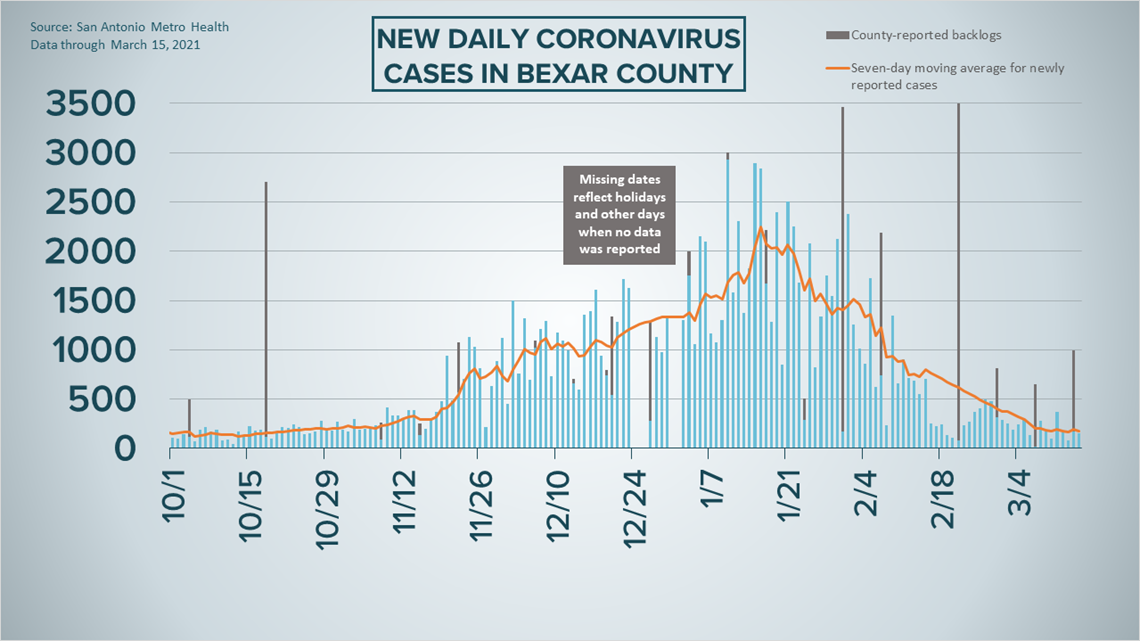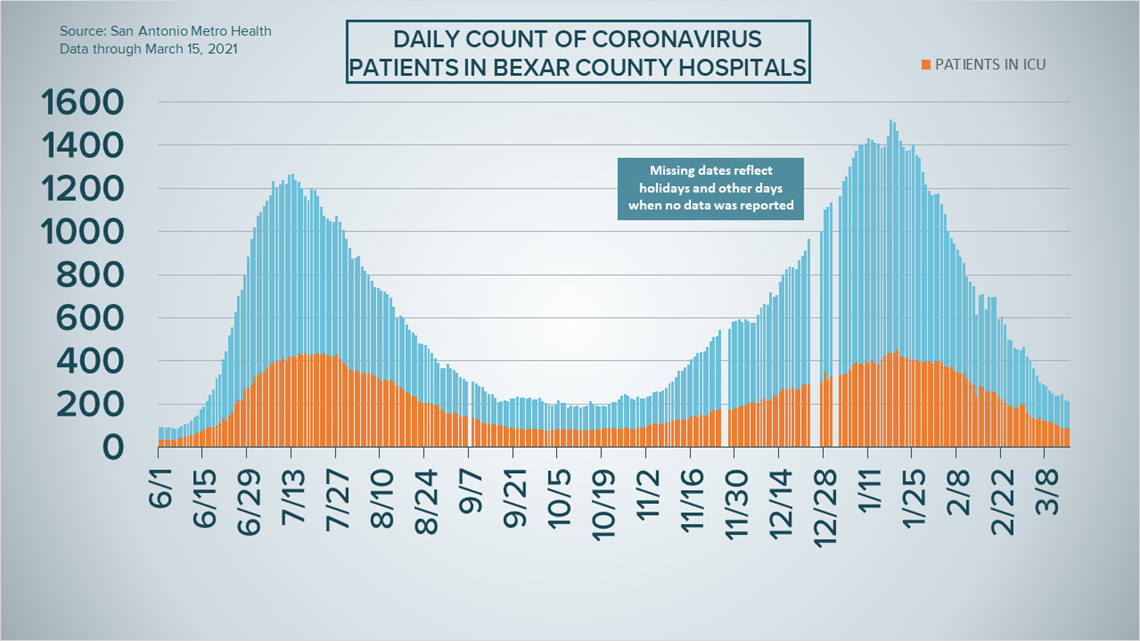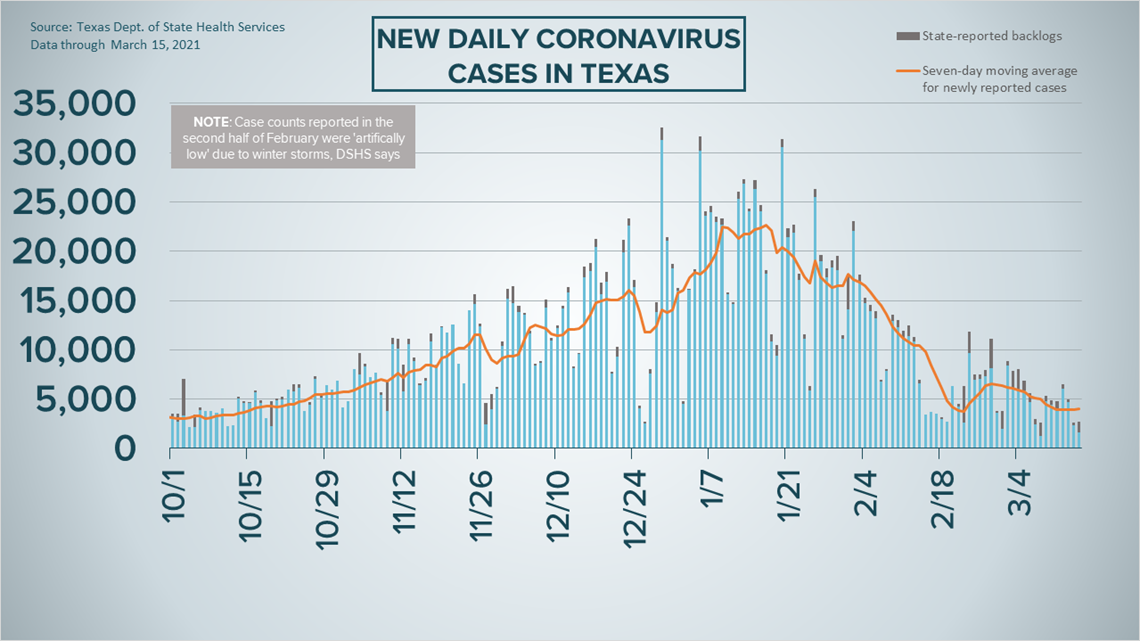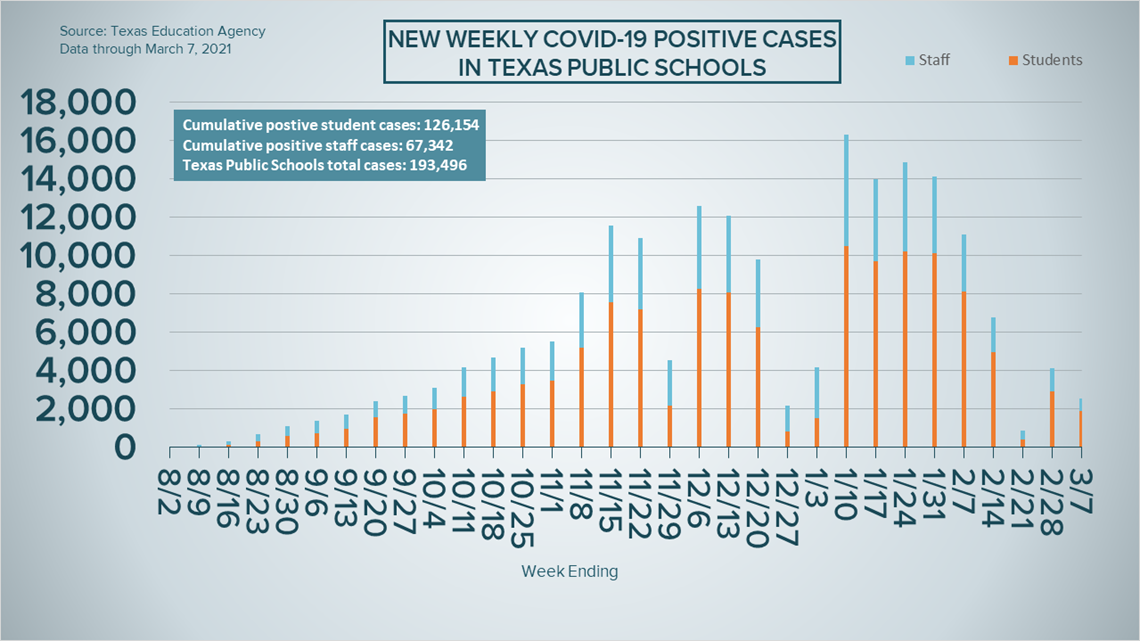SAN ANTONIO — We're tracking the latest numbers from the coronavirus pandemic in San Antonio and across Texas. Here are the latest numbers reported by Bexar and surrounding counties:
- Bexar County: On Monday, 154 new cases were reported, bringing the total number of cases to 200,818. No new deaths were also reported; the local death toll from virus complications remains at 2,990.
- Hays County: Hays County did not release new numbers Monday. On Friday, officials reported 17 new cases in the county and one additional COVID-related fatality. There is now a total of 16,668 lab-confirmed local cases, while the death toll increased to 232. Officials estimate 15,990 residents have recovered, while 446 are still ill with the virus.
- Comal County: Officials reported 39 new cases on Tuesday, along with no additional virus-related deaths. As of Tuesday, 9,475 total COVID-19 cases have been reported, including 4,988 confirmed and 4,466 probable cases, while 302 county residents have died due to COVID-19 complications.
More county case information is available through the Texas Department of Health Services COVID-19 dashboard.
How Bexar County is trending
We've tracked how many coronavirus cases have been confirmed in Bexar County from the time officials began reporting cases in March 2020. The graphic below shows the number of cases since June and charts those daily case numbers along a 7-day moving average to provide a more accurate picture of the overall coronavirus case curve in our area and the direction we're trending amid the pandemic.
On Monday, San Antonio Mayor Ron Nirenberg reported 154 new coronavirus cases in Bexar County, bringing the total number of local cases to 200,818. The seven-day rolling case average dropped to 171.
No additional virus-related deaths were reported in the community; in all, 2,990 Bexar County residents have died from virus complications.


Local hospitalizations dropped slightly to 215 COVID-19 patients receiving treatment at area facilities, which is one fewer than Sunday. Over the last 24 hours, 22 new patients were admitted to local hospitals. Of the 215 currently-hospitalized patients, 53 patients are on ventilators and 90 are in intensive care.


In Monday's weekly update of Bexar County's progress and warning indicators, health officials noted that the positive rate had jumped to 5.6% over the previous week, a change of three percentage points. Nirenberg attributed the rise to a decrease in testing over the last week, possibly caused by Spring Break.
The case rate per 100,000, meanwhile, dropped to 9.1. Bexar County remains in the low risk level, as tracked by Metro Health.
Coronavirus in Texas
The total number of novel coronavirus cases in the state since the pandemic began grew by 2,744 on Monday, according to the Texas Department of State Health Services. That total includes 1,437 new confirmed cases, 173 new probable cases, and a backlog of 1,134 cases. More details can be found on this page.
Monday's figures bring the total number of Texans diagnosed with COVID-19 to more than 2.721 million.


Meanwhile, state health authorities reported an additional 27 deaths from coronavirus complications in Texas. In all, 45,570 Texans have died from COVID-19 complications.
The number of concurrent hospitalizations across the state has decreased for the sixth day in a row, this time by 113 to 3,980 COVID-19 patients receiving treatment for their symptoms across the state, as of Monday. The last time the figure was below 4,000 was October 11.
The state, meanwhile, estimates that about 2.56 million Texans have recovered, while 111,498 Texans remain ill with COVID-19.
The latest update from the Texas Education Agency showed that there have been at least 193,496 cumulative cases among staff and students on Texas public school campuses through March 7. That number comprises 126,154 positive student cases and 67,342 staff cases. More information can be found here.


The TEA typically releases new data on school cases on Fridays.
- UConn's Geno Auriemma tests positive for COVID-19
- Experts say coronavirus vaccines are safe and effective
- Facebook to label vaccine posts to combat COVID-19 misinformation
- Biden addresses $1.9T relief plan's benefits
- Why countries are halting the AstraZeneca shot
- Noodle Tree restaurant vandalized with racist graffiti after owner took stand on wearing masks
- Beachgoers celebrate spring break after COVID-19 mask order lifted in Texas
- Extent of COVID-19 vaccine waste remains largely unknown
- Ballet dancers flow with the challenges of a pandemic | Kids Who Make San Antonio Great
Coronavirus symptoms
The symptoms of coronavirus can be similar to the flu or a bad cold. Symptoms include fever or chills, cough, shortness of breath or difficulty breathing, fatigue, muscle or body aches, headache, new loss of taste or smell sore throat, congestion or runny nose, nausea or vomiting, and diarrhea, according to the Centers for Disease Control.
Most healthy people will have mild symptoms. A study of more than 72,000 patients by the Centers for Disease Control in China showed 80 percent of the cases there were mild.
But infections can cause pneumonia, severe acute respiratory syndrome, kidney failure, and even death, according to the World Health Organization. Older people with underlying health conditions are most at risk.
Experts determined there was consistent evidence these conditions increase a person's risk, regardless of age:
- Chronic kidney disease
- COPD (chronic obstructive pulmonary disease)
- Obesity (BMI of 30 or higher)
- Immunocompromised state (weakened immune system) from solid organ transplant
- Serious heart conditions, such as heart failure, coronary artery disease, or cardiomyopathies
- Sickle cell disease
- Type 2 diabetes
- The CDC believes symptoms may appear anywhere from two to 14 days after being exposed.
Human coronaviruses are usually spread...
- Between people who are in close contact with one another (within about 6 feet).
- Through respiratory droplets produced when an infected person coughs, sneezes or talks. These droplets can land in the mouths or noses of people who are nearby or possibly be inhaled into the lungs.
- Some recent studies have suggested that COVID-19 may be spread by people who are not showing symptoms.
Help stop the spread of coronavirus
- Stay home when you are sick.
- Eat and sleep separately from your family members
- Use different utensils and dishes
- Cover your cough or sneeze with your arm, not your hand.
- If you use a tissue, throw it in the trash.
Find a Testing Location
City officials recommend getting a COVID-19 test if you experience fever or chills, cough, shortness of breath or difficulty breathing, fatigue, muscle or body aches, headache, new loss of taste or smell, sore throat, congestion or runny nose, nausea or vomiting, or diarrhea.
Here's a Testing Sites Locator to help you find the testing location closest to you in San Antonio.

